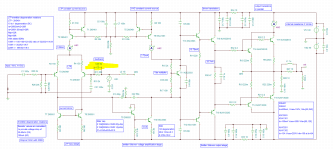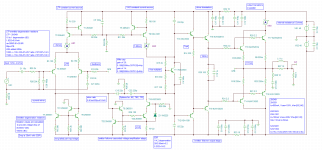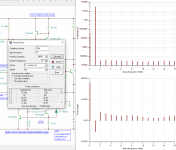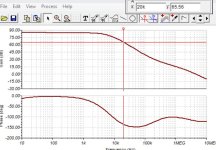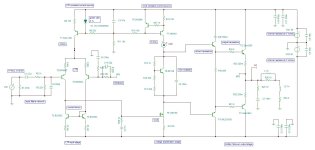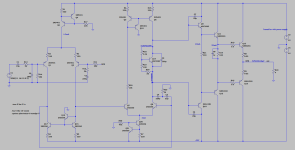Nice , Good fun
just like the simplified version once DC is well balanced it really wakes up performance wise.
with small signal, far as I remember LM318 opamp used similar topology , using what laterals were good for.
Small Signal High speed P channel.
Might not be big deal now But 318 was early first high speed, wide bandwidth opamp
15 MHz and 50V/u slew rate which was miles miles above 741 at 1 MHz 0.5V/u
anyways topology is similar, was a big deal at the time. faster p channel made it possible
just like the simplified version once DC is well balanced it really wakes up performance wise.
with small signal, far as I remember LM318 opamp used similar topology , using what laterals were good for.
Small Signal High speed P channel.
Might not be big deal now But 318 was early first high speed, wide bandwidth opamp
15 MHz and 50V/u slew rate which was miles miles above 741 at 1 MHz 0.5V/u
anyways topology is similar, was a big deal at the time. faster p channel made it possible
Exactly, why I got bored with high parts count to get certain level of performance
with common single Vas circuits
When even a simplified mirror dual Vas
Will be equal or better
with common single Vas circuits
When even a simplified mirror dual Vas
Will be equal or better
Get the most with the least. I used the "backend" of the main CCS to give my VAS cascode a good reference.
That eliminated decoupling and any ground reference , more PPM.
I built this 8 years ago without the LTP current mirror and 2 pole , worked good ... but not stellar.
OS
That eliminated decoupling and any ground reference , more PPM.
I built this 8 years ago without the LTP current mirror and 2 pole , worked good ... but not stellar.
OS
Yes , forgot to comment on the vas cascode
noticed that ,pretty cool
further change can be simplified or elaborate dual differential
seems tradeoff for wider bandwidth, and PSRR
might take hit on slew rate.
somewhat same jump in opamp land history.
318 was big deal at 15 MHz but things jumped to 50 MHz with dual diff.
but slew fell from 318 50V/u to common 30V/u
THD numbers might look little better if feedback loop is direct coupled.
then servos come into play.
noticed that ,pretty cool
further change can be simplified or elaborate dual differential
seems tradeoff for wider bandwidth, and PSRR
might take hit on slew rate.
somewhat same jump in opamp land history.
318 was big deal at 15 MHz but things jumped to 50 MHz with dual diff.
but slew fell from 318 50V/u to common 30V/u
THD numbers might look little better if feedback loop is direct coupled.
then servos come into play.
Last edited:
H
HAYK
It is by subjective point of view you determined that Frank's My Way was recorded with a distorting microphone. I believe that the dirty sound we are hearing because of data loss due to beat that our ears are unable to reconstruct the individual voices. The higher the NFB the faster is the closed loop phase shift and less is the data loss of the beat.That is subjective.
OS
likely, and is real question to high frequency performance.
plenty real distortion and theoretical distortions first considered real then abandoned.
But all leads back to being reality, with combination of bandwidth and slew rate.
Then however low distortion is, the phase of the higher harmonics.
plenty real distortion and theoretical distortions first considered real then abandoned.
But all leads back to being reality, with combination of bandwidth and slew rate.
Then however low distortion is, the phase of the higher harmonics.
Or $hitty speakers ?It is by subjective point of view you determined that Frank's My Way was recorded with a distorting microphone. I believe that the dirty sound we are hearing because of data loss due to beat that our ears are unable to reconstruct the individual voices. The higher the NFB the faster is the closed loop phase shift and less is the data loss of the beat.
OS
H
HAYK
There are several mysteries about subjective distortions. Two types to distinguish, multiple voices of same note from flat to sharp, as in large jazz orchestras when multiple horns play, instead of hearing pleasant beat you get dirty sound. The second type occurs only with male metallic voices as Pavarotti where the high harmonics generate a nonharmoni component. The mystery is that when I inject these sounds into a simulating model instead of generator, when I listen to the output wave file, there is nothing wrong It.
yeah that is what I was thinking too. because speaker quality and the original recording come into play.
way before its even logical to discuss if you can tell .01% to .001% above 8 kHz.
with decent metal dome or ribbon relatively easy to get.
and even "8 ohm" speakers the tweet can dip to 6 or 3 ohms.
so bragging rights could be bandwidth and THD on 3 ohm load.
adding redundant amount of output devices is always fun.
think I take very high slew rate over raw THD numbers.
I prefer 8 ohm loads as well. but like the 10k THD %
to be holding up more than 20k
and relatively easy to do. basically triple with redundant amount of output
devices to hold up at 3 ohms
way before its even logical to discuss if you can tell .01% to .001% above 8 kHz.
with decent metal dome or ribbon relatively easy to get.
and even "8 ohm" speakers the tweet can dip to 6 or 3 ohms.
so bragging rights could be bandwidth and THD on 3 ohm load.
adding redundant amount of output devices is always fun.
think I take very high slew rate over raw THD numbers.
I prefer 8 ohm loads as well. but like the 10k THD %
to be holding up more than 20k
and relatively easy to do. basically triple with redundant amount of output
devices to hold up at 3 ohms
Last edited:
H
HAYK
High slew rate is necessary in class AB amps so that the feedback can reduce the crossover distortion effectively. Most music sources nowadays come from sampled form which has undergone brick wall steep filter taking off anything above 20khz. By this the Amp never gets in its input full excursion over 20khz.
H
HAYK
Here is another proposition. The supply ground is not as many think 0 impedance. Worst occurs when the positive input is ground referenced, it provokes unity gain positive feedback. This why amplifiers require armada of supply capacitors to decrease back the impedance to have lower frequencies powerful. The solution is to apply a virtual ground common for both channel as shown bellow.
Attachments
H
HAYK
I see 5pf cap in parallel with the feedback resistor? compensation?I did it for you as example.
what about using cascode in VAS? improve anything further?
Attachments
H
HAYK
This capacitor is called lead as is leads the phase. It dates the tube Era. It is also possible to add a series resistor to C15 so that when the second pole starts, it gets a zero and let's the second pole act alone for a while.
When you run the AC anaysis, you can see the phase margins.
When you run the AC anaysis, you can see the phase margins.
Here is the latest revision - added helper transistor to the current mirror and clipping transistor to VAS. See attached.
I wonder if 2n5551 and 2n5401 are the best transistors for the job?
I have been looking at this KSA992 and it seems like it has crazy hfe of 500 comparing to around 150 for 2n5401.
I am planning on using SMD parts for IPS and partially for VAS. Here are parts that I found:
Dual matched 5401 and 5551:
FMBM5401
FMBM5551
Single 5401 and 5551:
MMBT5401
MMBT5551
I am also considering SMD version of KSA992:
FJV992
And it looks like MPSA42 is great for VAS so I have found SMD version for that one:
MMBTA42
Other decent hfe at 65V SMD transistors are:
BC856BW
BC846BW
Dual / current gain matched versions:
BC856BS
BC846BS
And medium power
BCP53-16HX
BCP56-16HX
I wonder if 2n5551 and 2n5401 are the best transistors for the job?
I have been looking at this KSA992 and it seems like it has crazy hfe of 500 comparing to around 150 for 2n5401.
I am planning on using SMD parts for IPS and partially for VAS. Here are parts that I found:
Dual matched 5401 and 5551:
FMBM5401
FMBM5551
Single 5401 and 5551:
MMBT5401
MMBT5551
I am also considering SMD version of KSA992:
FJV992
And it looks like MPSA42 is great for VAS so I have found SMD version for that one:
MMBTA42
Other decent hfe at 65V SMD transistors are:
BC856BW
BC846BW
Dual / current gain matched versions:
BC856BS
BC846BS
And medium power
BCP53-16HX
BCP56-16HX
Attachments
H
HAYK
You have diverged too far to be still called JAD50. I did a quick sketch of enhancements to the original. The C5200/A1943 I use are from Toshiba and have more distortion than yours, despite I have 0.006% instead of 0.2% with 65db@20khz with perfect square wave.
Attachments
Revisiting this Hitachi amp with few additions. Having fun. This time it is in LTSpice lolThis classic topology below will perform same results
or better, with tremendous reduction in parts count.
Attachments
- Home
- Amplifiers
- Solid State
- JAT501 simulated using TINA TI and possible improvements

